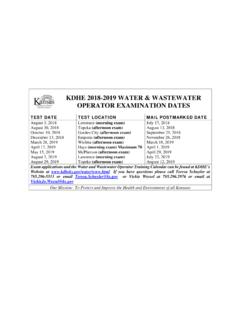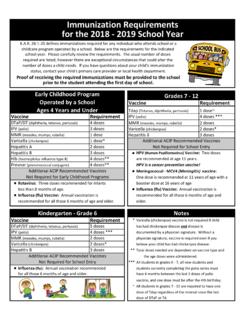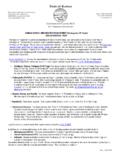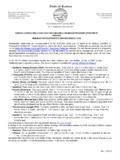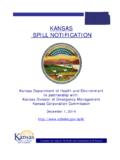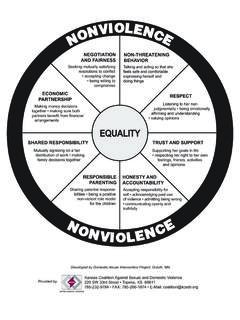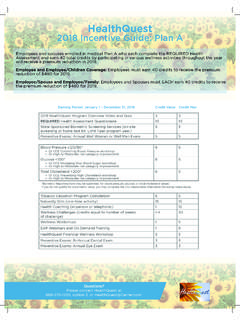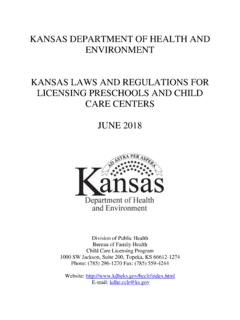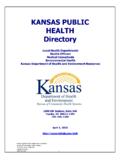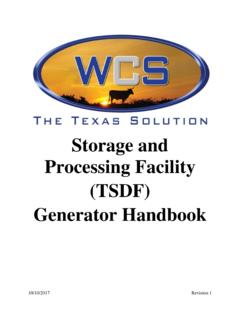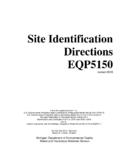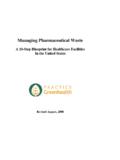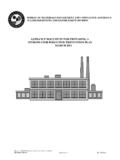Transcription of Hazardous Waste Generator Handbook - KDHE
1 Hazardous Waste Generator Handbook May 1, 2011 Revised April 16, 2014 A Guide to Complying with Kansas Hazardous Waste Generator Regulations Kansas Department of Health and Environment Division of Environment Bureau of Waste Management 1000 SW Jackson, Suite 320 Topeka, KS 66612-1366 (785) 296-1600 DISCLAIMER: This Handbook supersedes all previous editions of this publication. The information contained in this Handbook is an overview of the Hazardous Waste management program in Kansas. The state and federal regulations should be consulted for more detailed information. 2 Hazardous Waste Generator Handbook table of Contents I. Background 4 II. Purpose 4 III. Who Generates Hazardous Waste and Who Does Not? 5 IV. What is a Hazardous Waste ? 5 Insert. Hazardous Waste Determinations and Documentation, HW-2010-G1 6 Insert. Characteristic and Listed Hazardous Wastes, HW-2011-G2 9 V. What Quantities of Hazardous Waste are Regulated?
2 13 VI. Generator Classifications 14 VII. Summary of Generator Requirements 14 A. Conditionally Exempt Small Quantity Generator (CESQG) Requirements 14 B. Kansas Small Quantity Generator (KSQG) Requirements 17 C. Small Quantity Generator (SQG) Requirements 21 D. Large Quantity Generator (LQG) Requirements 25 VIII. Land Disposal Restrictions (40 CFR 268) and Hazardous Waste Manifesting (40 CFR 262) 29 IX. Choosing a Hazardous Waste Management Facility and/or Hazardous Waste Transporter/Contractor 30 X. How to Avoid Compliance Problems and Minimize Liability 31 XI. Resources Available to Assist in Properly Managing Hazardous Waste 32 Attachment 1 - Toxicity Characteristic Constituents Regulatory Limits and Waste Codes 34 Attachment 2 - Hazardous Wastes From Non-Specific Sources (F-List) 36 Attachment 3 - Hazardous Wastes from Specific Sources (K-List) 40 Attachment 4 Discarded Acutely Toxic Commercial Chemical Products, Off-Specification Species, Container Residues and Spills Thereof (P-List) 47 Attachment 5 - Discarded Commercial Chemical Products, Off-Specification Species, Container Residues and Spills Thereof (U-List) 60 Attachment 6 - Training/Compliance Manual 85 3 I.
3 Background The first effort to regulate Hazardous Waste management on a national level occurred in 1976 with the passage by Congress of the Resource Conservation and Recovery Act (RCRA). The primary goal of the Act was to encourage the conservation of natural resources through resource recovery. RCRA also provided the statutory basis for the federal Hazardous Waste regulations. The regulations that have evolved into the current regulatory program were first issued in May of 1980. A key section of the Act provided for states to operate the Hazardous Waste management program in lieu of the Environmental Protection Agency (EPA). The State of Kansas first passed legislation regarding Hazardous Waste management in 1977. The Kansas Department of Health and Environment ( kdhe ) obtained authorization to administer the Hazardous Waste management program from EPA in October of 1985. As a result, Hazardous Waste generators deal primarily with kdhe .
4 Since 1977, Kansas Hazardous Waste laws have been amended, with significant updates being made in 2011. With a few exceptions, kdhe has adopted the federal regulations by reference. In areas where the Kansas regulations have different requirements than the federal program, the Generator must comply with the state requirements. II. Purpose The proper management of Hazardous wastes can be a complex and challenging task. This publication was prepared to be used as a guide to help you determine whether your facility is subject to state and federal Hazardous Waste management statutes and regulations. By reviewing Waste generation and disposal practices, and using this guide, a person should be able to do the following: Determine whether your facility generates Hazardous wastes; Determine how those wastes are regulated under the Kansas Hazardous Waste management program; Learn what you must do to comply with the Kansas Hazardous Waste management statutes and regulations; Learn what alternative Hazardous Waste management options are available to a Hazardous Waste Generator ; and Learn what resources are available to assist you in complying with the statutes and regulations.
5 The Hazardous Waste statutes place the primary responsibility for ensuring that Hazardous wastes are properly managed on the person/facility who generates those wastes. The Generator must identify all Hazardous wastes and be certain that they are transported and disposed in accordance with the law. While the Generator can contract with Hazardous Waste contractors or consultants to perform these activities on his or her behalf, the ultimate responsibility for complying with the laws remains with the Generator of the Waste . For this reason, it is important for all generators of Hazardous or potentially Hazardous wastes to become familiar with the statutes and regulations that apply to them. The Kansas statutes and regulations generally mirror federal laws and regulations but differences do exist between the two programs. To comply with all the state regulations fully, you must use the Kansas Hazardous Waste regulations with the federal regulations referenced in the various state regulations.
6 4 Complying only with the federal regulations found in Title 40 of the Code of Federal Regulations (40 CFR) will not allow you to operate in full compliance with the Kansas regulations. III. Who Generates Hazardous Waste and Who Does Not? Any business can be a Hazardous Waste Generator . A few examples of Hazardous Waste generators are businesses that use or handle large amounts of chemicals, manufacture items, perform maintenance activities, or conduct printing services. Wastes from households and most farm activities are exempt from the definition of Hazardous Waste . Therefore households and most farmers are not generators of Hazardous Waste . However, some wastes generated by households and farmers are very Hazardous and should be managed appropriately. Most Kansas citizens have access to a household Hazardous Waste (HHW) collection facility. These HHW facilities are permitted by kdhe to collect wastes from households that may be Hazardous and to keep HHW out of our landfills and out of our groundwater and surface water.
7 kdhe encourages all citizens to utilize HHW facilities whenever possible. IV. What is a Hazardous Waste ? Hazardous Waste is a special category or subset of all wastes that businesses and industries generate. For a material to be a Hazardous Waste , the material must first be classified as a solid Waste . Generally speaking, a material is a Waste when it can no longer be used for its intended purpose and will be disposed, reclaimed, or recycled. Hazardous wastes are wastes known to be harmful or potentially harmful to human health or the environment. The process used to determine if a Waste is Hazardous is referred to as the Hazardous Waste determination. The following sections will detail the process of making an adequate Hazardous Waste determination, and also explain the different ways a Waste can be Hazardous (characteristic and listed). These sections are in the form of Technical Guidance Documents. For a complete list of Technical Guidance Documents, see the kdhe BWM website (address found on the cover of this document).
8 5 Page 1 of 2 Kansas Department of Health and EnvironmentBureau of Waste Management 1000 SW Jackson, Suite 320, Topeka, Kansas 66612 Hazardous Waste Determinations and DocumentationTechnical Guidance Document H Businesses, government agencies, institutions, and other concerns generate many types of wasterequired to determine if any of their Waste requirement. This technical guidance document determination and the associated documentation requirementswaste stream and should not be used withoutto in this document have been adopted by Making Waste Determinations Hazardous Waste determinations can be complicated, and must be done for every Waste stream generated at a facility. Generallyonly Waste stream that is not required to have a documented Waste determination is office trash. Breaking the Waste determination into steps can make it easier to complete the process. Step 1 Make a list of all Waste streams being generated at the facility.
9 List what process generates each Waste stream, and document how many pounds of each Waste stream are generated each month (don t average over months). Step 2 Check to see if each Waste meets the definition of solid Waste as found in the Code of Federal Regulations, 40 CFR Waste is solid Waste if it: Is a solid or a liquid (or in some cases a gas)that is discarded, abandoned, recycled, or considered inherently Waste -like; and Is not otherwise exempt from the definition of solid Waste under 40 CFR (a). One common way that materials become exempt from the definition of solid Waste when they are discharged to a sewer or that is regulated under the Clean Water Actexample an NPDES discharge pointtreatment system, or a Publicly Treatment Works (POTW). Kansas Department of Health and Environment 1000 SW Jackson, Suite 320, Topeka, Kansas 66612-1366 Hazardous Waste Determinations and Documentation echnical Guidance Document HW-2011-G1 Businesses, government agencies, institutions, and other concerns generate many types of wasteany of their Waste is Hazardous .
10 Only household Waste is exempt from this guidance document (TGD) explains the steps involved in making a documentation requirements. This guidance is not designed for every and should not be used without consulting the regulations. The Federal Regulations referred adopted by Kansas in KAR 28-31-261. Hazardous Waste determinations can be complicated, and must be done for every Waste facility. Generally, the not required to have a ocumented Waste determination is office trash. Breaking the Waste determination into steps can make it easier to complete the process. Make a list of all Waste streams being generated List what process generates each how many pounds of each Waste stream are generated each month Check to see if each Waste meets the definition Code of Federal Waste is considered in some cases a gas) that is discarded, abandoned, recycled, or and s not otherwise exempt from the definition of solid Waste under 40 CFR (a).
